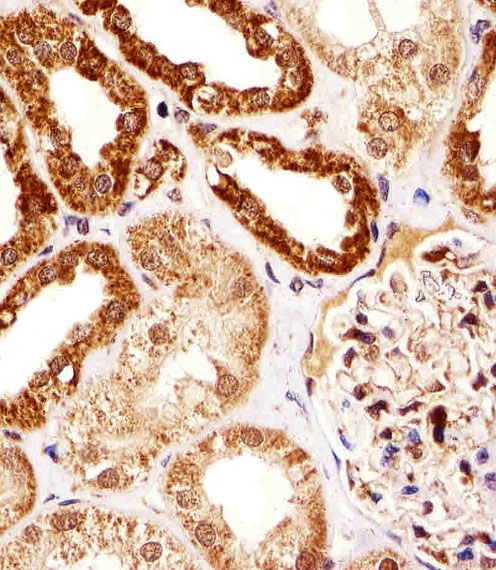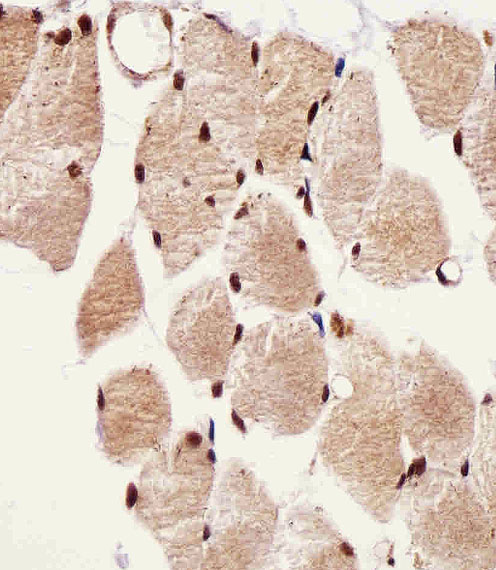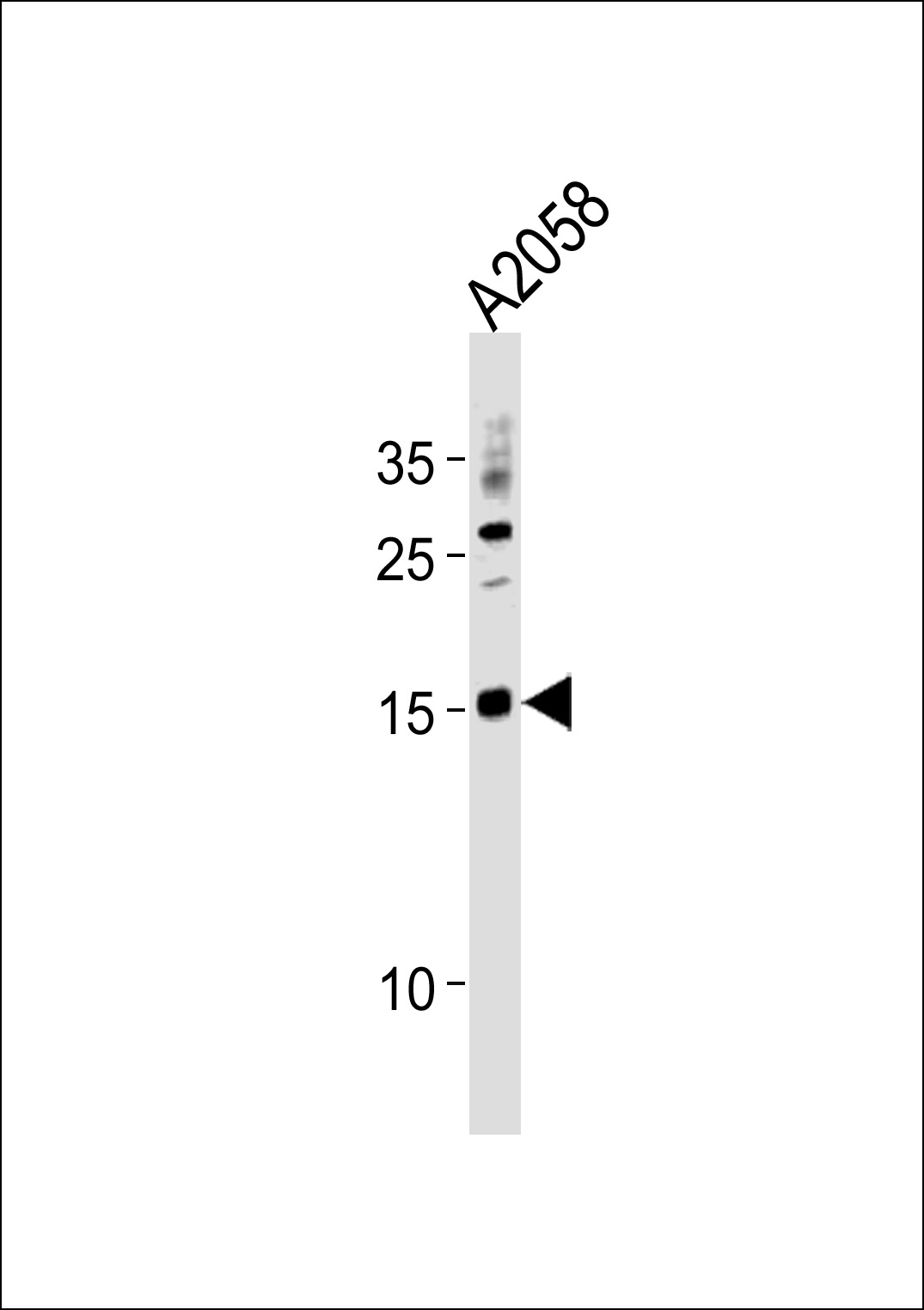SSNA1 Antibody (N-term)
Affinity Purified Rabbit Polyclonal Antibody (Pab)
- 产品详情
- 实验流程
Application
| WB, IHC-P, E |
|---|---|
| Primary Accession | O43805 |
| Other Accession | Q9JJ94, Q5E9C3 |
| Reactivity | Human, Mouse |
| Predicted | Bovine, Mouse |
| Host | Rabbit |
| Clonality | Polyclonal |
| Isotype | Rabbit IgG |
| Calculated MW | 13596 Da |
| Antigen Region | 25-53 aa |
| Gene ID | 8636 |
|---|---|
| Other Names | Sjoegren syndrome nuclear autoantigen 1, Nuclear autoantigen of 14 kDa, SSNA1, NA14 |
| Target/Specificity | This SSNA1 antibody is generated from rabbits immunized with a KLH conjugated synthetic peptide between 25-53 amino acids from the N-terminal region of human SSNA1. |
| Dilution | WB~~1:1000 IHC-P~~1:100~500 E~~Use at an assay dependent concentration. |
| Format | Purified polyclonal antibody supplied in PBS with 0.09% (W/V) sodium azide. This antibody is purified through a protein A column, followed by peptide affinity purification. |
| Storage | Maintain refrigerated at 2-8°C for up to 2 weeks. For long term storage store at -20°C in small aliquots to prevent freeze-thaw cycles. |
| Precautions | SSNA1 Antibody (N-term) is for research use only and not for use in diagnostic or therapeutic procedures. |
| Name | SSNA1 (HGNC:11321) |
|---|---|
| Function | Microtubule-binding protein which stabilizes dynamic microtubules by slowing growth and shrinkage at both plus and minus ends and serves as a sensor of microtubule damage, protecting microtubules from the microtubule-severing enzyme SPAST (PubMed:34970964). Induces microtubule branching which is mediated by the formation of long SSNA1 fibrils which guide microtubule protofilaments to split apart from the mother microtubule and form daughter microtubules (By similarity). Plays a role in axon outgrowth and branching (PubMed:25390646). Required for cell division (PubMed:25390646). |
| Cellular Location | Nucleus. Cytoplasm, cytoskeleton, microtubule organizing center, centrosome. Cytoplasm, cytoskeleton, microtubule organizing center, centrosome, centriole Midbody. Cytoplasm, cytoskeleton, flagellum basal body. Cytoplasm, cytoskeleton, flagellum axoneme. Cell projection, axon {ECO:0000250|UniProtKB:Q9JJ94}. Note=In sperm, strongly expressed in the basal body region with weaker expression in the axoneme (PubMed:12640030). Localizes to axon branching points in neurons (By similarity). {ECO:0000250|UniProtKB:Q9JJ94, ECO:0000269|PubMed:12640030} |
| Tissue Location | Widely expressed.. |
Research Areas
For Research Use Only. Not For Use In Diagnostic Procedures.
Application Protocols
Provided below are standard protocols that you may find useful for product applications.
REFERENCES
Ramos-Morales F., et al. J. Biol. Chem. 273:1634-1639(1998).
Kalnine N., et al. Submitted (MAY-2003) to the EMBL/GenBank/DDBJ databases.
Halleck A., et al. Submitted (JUN-2004) to the EMBL/GenBank/DDBJ databases.
Humphray S.J., et al. Nature 429:369-374(2004).
Mural R.J., et al. Submitted (JUL-2005) to the EMBL/GenBank/DDBJ databases.
终于等到您。ABCEPTA(百远生物)抗体产品。
点击下方“我要评价 ”按钮提交您的反馈信息,您的反馈和评价是我们最宝贵的财富之一,
我们将在1-3个工作日内处理您的反馈信息。
如有疑问,联系:0512-88856768 tech-china@abcepta.com.























 癌症的基本特征包括细胞增殖、血管生成、迁移、凋亡逃避机制和细胞永生等。找到癌症发生过程中这些通路的关键标记物和对应的抗体用于检测至关重要。
癌症的基本特征包括细胞增殖、血管生成、迁移、凋亡逃避机制和细胞永生等。找到癌症发生过程中这些通路的关键标记物和对应的抗体用于检测至关重要。 为您推荐一个泛素化位点预测神器——泛素化分析工具,可以为您的蛋白的泛素化位点作出预测和评分。
为您推荐一个泛素化位点预测神器——泛素化分析工具,可以为您的蛋白的泛素化位点作出预测和评分。 细胞自噬受体图形绘图工具为你的蛋白的细胞受体结合位点作出预测和评分,识别结合到自噬通路中的蛋白是非常重要的,便于让我们理解自噬在正常生理、病理过程中的作用,如发育、细胞分化、神经退化性疾病、压力条件下、感染和癌症。
细胞自噬受体图形绘图工具为你的蛋白的细胞受体结合位点作出预测和评分,识别结合到自噬通路中的蛋白是非常重要的,便于让我们理解自噬在正常生理、病理过程中的作用,如发育、细胞分化、神经退化性疾病、压力条件下、感染和癌症。








